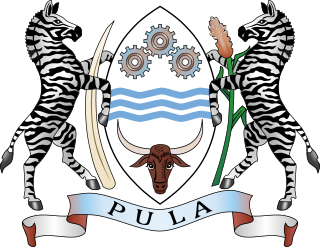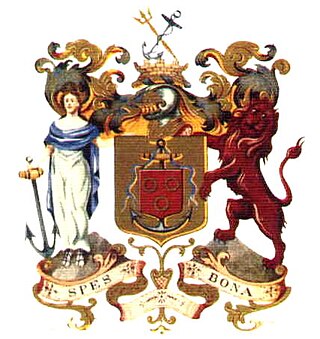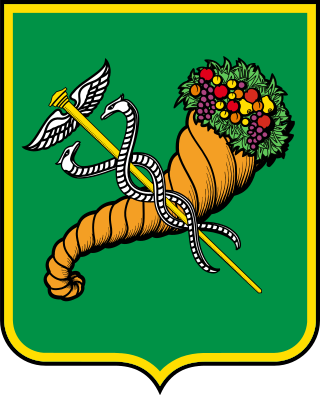
The coat of arms of South Africa is the main heraldic insignia of South Africa. The present coat of arms was introduced on Freedom Day, 27 April 2000, and was designed by Iaan Bekker. It replaced the earlier national arms, which had been in use since 1910. The motto is written in the extinct |Xam, member of the Khoisan languages, and translates literally to "diverse people unite". The previous motto, in Latin, was Ex Unitate Vires, translated as "From unity, strength".

The coat of arms of the city of Canberra, was granted to the Federal Capital Commission, its successors and the City of Canberra by King George V in 1928. It has been used by the Australian Capital Territory as its de facto coat of arms, as the territory does not have its own coat of arms. A modified version of this coat of arms also appears on the flag of the Australian Capital Territory since 1993.
Eichstätt is a Landkreis (district) in Bavaria, Germany. It is bounded by the districts of Neuburg-Schrobenhausen, Donau-Ries, Weißenburg-Gunzenhausen, Roth, Neumarkt, Kelheim and Pfaffenhofen, and by the city of Ingolstadt.
Schmalkalden-Meiningen is a Landkreis in the southwest of Thuringia, Germany. Its neighboring districts are the districts Wartburgkreis, Gotha, Ilm-Kreis, the district-free city Suhl, the district Hildburghausen, the Bavarian district Rhön-Grabfeld, and the district Fulda in Hesse.

The coat of arms of Jordan or the Emblem of the Hashemite Kingdom of Jordan is the arms of dominion for the king of Jordan. The emblem was initially adopted by Abdullah I, the Emir of Transjordan, in 1921. The emblem continued to be used after Transjordan emerged as an independent kingdom in 1946.

The national flag of Egypt is a tricolour consisting of the three equal horizontal red, white, and black bands of the Egyptian revolutionary flag that dates back to the 1952 Egyptian Revolution. The flag bears Egypt's national emblem, the Egyptian eagle of Saladin, centred in the white band.

The coat of arms of Botswana was adopted on 25 January 1966. The centre shield is supported by two zebras. The shape of the shield is that of traditional shields found in Southern Africa. On the top portion of the shield are three cogwheels that represent industry.

The coat of arms of Romania was adopted in the Romanian Parliament on 10 September 1992 as a representative coat of arms for Romania. The current coat of arms is based on the lesser coat of arms of interwar Kingdom of Romania, which was designed in 1921 by the Transylvanian Hungarian heraldist József Sebestyén from Cluj, at the request of King Ferdinand I of Romania, it was redesigned by Victor Dima. As a central element, it shows a golden aquila holding a cross in its beak, and a mace and a sword in its claws. It also consists of the three colors which represent the colors of the national flag. The coat of arms was augmented on 11 July 2016 to add a representation of the Steel Crown of Romania.

The coat of arms of Cyprus may refer to the national symbol used in the Republic of Cyprus.

The coat of arms of New South Wales is the official coat of arms of the Australian state of New South Wales. It was granted by royal warrant of King Edward VII dated 11 October 1906.

The Emblem of Nepal is the national emblem of Nepal and is used by the Government of Nepal and many government agencies. On 13 June 2020, the emblem was revised to include the newly issued map which includes Nepalese claims to the Kalapani territory and Lipulekh Pass.

The coat of arms of Cape Town is the traditional symbol of the municipality of Cape Town. The original arms from the 20th century are no longer in official use, though no new arms have yet been adopted.

The coat of arms of Trondheim is based on the medieval seal of the city. The seal is probably from the 13th century, but its earliest preserved form is on a document from 1344. The coat of arms was assumed by the city council in 1897, and has a more intricate design than most other Norwegian coats of arms.

The Coat of arms of Kharkiv is the official coat of arms of both Kharkiv city and Kharkiv Oblast.

The flag of Amsterdam is the official flag for Amsterdam, the capital of the Netherlands. The current design of the flag depicts three Saint Andrew's Crosses and is based on the escutcheon in the coat of arms of Amsterdam.

The flag of the City of London is based on the flag of England, having a centred red St George's Cross on a white background, with the red sword in the upper hoist canton. The sword is believed to represent the sword that beheaded Saint Paul, who is the patron saint of the city. The tip of the sword always points upwards; therefore, when the flag is held on its side as a banner, the sword would be printed to face hoist and would be located on the left as it is hanging down.
The flag and the coat of arms of Negeri Sembilan are state symbols of Negeri Sembilan, Malaysia. The symbols are predominantly depicted in red, black and yellow, traditional colours of the Minangkabau people who are the original settlers in the present-day state. Also recognised in the symbols are the political history of Negeri Sembilan, its ruler, and the state's past relationship with the British Empire.

The City of Manchester in North West England has traditionally been represented by various symbols. Most of these symbols are derived from heraldic emblems contained within the city's official heraldic achievement, which was officially adopted when the Borough of Manchester was granted city status in 1842. Notably, the motif of the worker bee has been widely used to represent the city as a symbol of industry.

The Oxfordshire flag is the flag of the historic county of Oxfordshire in England. It was registered with the Flag Institute on 9 October 2017.

Alexander II is a monumental statue located at the Senate Square in central Helsinki, Finland.

















